
月波
Geppa ◆ ゲッパ
3.67
Osaka Station, Umeda, Shinchi
「Japanese Cuisine」
15,000-19,999円
1,000-1,999円
Opening hours: 18:00 - 23:00Please call for reservations Monday through Saturday between 11:00 am and 5:00 pm. Open Sunday
Rest time: Sunday
大阪府大阪市北区曽根崎新地1-7-6 新日本新地ビル 東館 1F
Photos
(20)



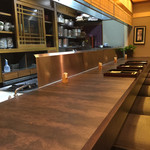
















Details
Reservation Info
can be reserved
Payment Method
Credit cards accepted
(VISA, Master, JCB, AMEX, Diners)
Electronic money is not accepted
QR code payment is not accepted.
Restaurant Service Fee
10% service charge
This fee is charged by the restaurant, not related to our platform
Number of Seats
44 seats
Private Dining Rooms
Yes (2 people, 4 people, 6 people, 8 people, 10-20 people, 20-30 people)
(Can accommodate 2 people, 4 people, 6 people, 8 people, 10-20 people, 20-30 people)
Private rooms are also available. Private rooms can be reserved for up to 23 persons *Private rooms in October, November, and December are available for a minimum of 3 persons.
Smoking and Non-Smoking
All seats are non-smoking.
Parking
None
Facilities
Stylish space, calm space, large seats, counter seating, tatami room, sunken kotatsu
Drink
Sake available, shochu available, wine available, stick to sake, stick to shochu
Dishes
Focus on fish dishes
Comments
(20)
苦楽園の住人
4.00
It's been quite a while since I last visited this restaurant. The prices have gone up from around 8000 yen to 12000 yen now. Well, that's understandable since it's been many years. This place offers a course full of luxurious ingredients, starting with a huge spiny lobster. It was served along with rock oysters, both with deliciously firm textures. Next, there was conger eel sushi and octopus, which I really enjoyed. Then came grated yam with salmon roe, followed by a large portion of grilled matsutake mushrooms. There was also a thick and juicy grilled white eel, which I forgot to take a picture of. The meal ended with a delicious porridge. Considering the quality and quantity of the dishes, 12000 yen is quite a bargain! I will definitely visit this place again!

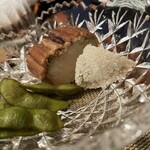


夜しか開かない精神科診療所OWL
4.00
The softshell turtle soup on the course was so delicious that I ended up paying extra for it. The porridge was heavenly. Grilling matsutake mushrooms while sipping on sake is fantastic. Offering this price range in Kita-Shinchi is divine. The part-time staff from Kandai Group also seem lively and happy to work. Thank you for the very pleasant service.


とんし
3.70
When I'm at work, I don't usually take photos, so I had someone who was with me send me some pictures, but the deadline on LINE expired and I couldn't download them. I'm sorry for that. I'll post a few blurry ones that I managed to capture. This restaurant seems to be well-known in Kita-Shinchi for its high-quality ingredients, like whale meat, which is used in a way that justifies the high prices. The nodoguro and kinmedai were delicious. While you can't expect top-notch sashimi like tuna, flounder, or sea bream at high-end restaurants, the grilled dishes, simmered dishes, and hot pot dishes allow the natural flavors of the ingredients to shine through. Since specialty items like tuna and sea urchin are available at the market, even if you can't get the very top-tier ones, you can still get close to them. Unlike popular sushi restaurants from Kyoto or Okayama, which charge around 50,000 yen for a meal with farmed ingredients, this restaurant is sincere in its sourcing of the best ingredients available at the central market in Osaka. However, the quality of the duck was not as high. I don't intend to criticize Osaka's dining establishments, but there are too many places in Osaka, Kyoto, and Kobe where the prices are high but the ingredients are cheap. While it may be possible to eat sashimi with delicious soy sauce and no one would notice, I don't understand why you would have to eat soy sauce at a high-end restaurant. If you're particular about soy sauce, the one you use at home is likely of higher quality, so if you want to do that, it would be better to buy tuna, flounder, or sea bream from a department store and eat them with high-quality soy sauce. Given this situation, I think this restaurant is good for casual Japanese dining, and I'd like to bring my wife here once her alcohol ban is lifted. Since my wife works in Osaka, we can come here anytime it works out. I'm not sure if the cost performance is good or bad, but using proper ingredients will naturally lead to a certain price point. However, what concerns me during my visits to high-end restaurants in Osaka is that it seems to be very difficult to hire service staff, and even at high-end establishments, the service quality is often lacking. Most of the staff seem to have received little training. The Italian restaurant in Grand Front Kyoto, which was said to be in Italy the day before the typhoon hit, had unbelievably terrible service. There are hardly any other places as bad as that, and while it may be due to a shortage of staff in Tokyo's city center as well, I am amazed at the poor service. That's why I think it's better for restaurants to be run by just the owner or a couple. It's the responsibility of the owner to properly educate the staff and not let young employees provide terrible service. Regardless of what happens in the business, it's the owner's responsibility. The restaurant industry is too lenient in this regard. There are very few owners with a sense of responsibility. That's why restaurants run by owners with a sense of responsibility will survive even in the post-COVID era.



drkck
3.50
It's great that they are flexible with time and seating. I didn't take any photos because I used it for a work dinner. The turtle and whale were delicious. It's a bit disappointing that the sea bream shabu-shabu is self-service. It was served for three people at once, so one person had to take charge of the pot. It would be nice if they provided individual pots for each person so that everyone can eat at their own pace.

どりら〜
3.50
For a group of 5 people, we booked this restaurant 2 days in advance for a Saturday night, which was quite busy. Luckily, we managed to check in here. The course menu had generous portions and was satisfying. There were impressive dishes like crab, steamed hot pot, and grilled cutlassfish, providing a sense of excitement. Sorry for the lack of photos... Overall, the individual dishes were decent, so it's best not to have too high expectations and just enjoy the experience.


tomokyun85
5.00
I finally visited Tsukinami in Kitashinchi, which my gourmet friends had recommended for a long time. Right from the start, dish after dish kept coming out. There were so many dishes that I even forgot to take photos halfway through. When I made the reservation, it was for the 12,500 yen course, but I received a call confirming the 18,000 yen course. It was a good choice. The timing of the dishes coming out was a bit quick, but it made me feel the restaurant's seriousness. And the parade of stunning ingredients was impressive. It was great that they had the grilled crab during this season. I definitely want to go back again!




kyuurikirai224
3.50
This is a Japanese restaurant where my friend made a reservation. We had delicious dishes such as sea bream roe, carabinero shrimp, octopus, and sweetfish with eggs. The simmered chrysanthemum flowers with them was also tasty, although I forgot to take a photo. The sashimi of spiny lobster was as expected. The raw abalone with liver and condiments was delicious. The charcoal-grilled crab and matsutake mushrooms really captured the season. The steamed egg custard was fluffy and tasty. We also had a soup with chicken broth, spiny lobster, sea bream, and clam broth, along with a shabu-shabu of conger eel. It felt like there was too much going into the soup (laughs). The udon noodles were also delicious. Although they mentioned there was meat available, we were too full to try it. Finally, we had dessert. The wine was just okay, but overall, I was very satisfied. Thank you for the meal.



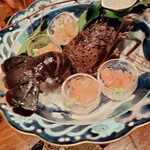
ドクター賢
3.80
We made a reservation and visited as a party of two. It was a typhoon day, so besides us, there was only one other couple in the private room. We started with bottled beer as usual. The appetizers for both parties were served first, which were quite ordinary. Then came the sashimi. First, we had spiny lobster, which tasted exceptional with just a sprinkle of salt. Next was black abalone, thinly sliced for easy eating and delicious in flavor. Then came flounder and tuna, both of which were tasty. Following that, we were served grilled domestic matsutake mushrooms and Hokkaido crab. We grilled the matsutake ourselves over charcoal, while the crab was a type of snow crab known as Zuwai-gani, and it was incredibly delicious, rivaling even the taste of Matsuba-gani. Lastly, we had a soup with conger eel and matsutake mushrooms. The conger eel from Numashima was large and delicious, and it was a good year for domestic matsutake mushrooms. The meal ended with tai zosui, which was also very tasty.




Mikutama
3.80
Kitashinchi's street shop on Eirakucho Street, Tsukinami-san. It was my first visit, but I felt a sense of nostalgia in the store, with luxurious dishes at a great cost-performance ratio. It's a perfect place for two adults to enjoy a drink at the counter. I was impressed by the fact that it is a long-standing famous restaurant. However, the master, who was considerate to us, seems to be strict in educating his apprentices, as we were taken aback by his slightly excessive scolding. While I understand that there may be various reasons behind it, I hope such behavior can be avoided in public. Thank you for the meal!



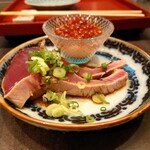
パサー
3.90
I had been curious about the traditional Japanese restaurant Tsukinami in Kitashinchi for quite some time, and finally went there for dinner on a holiday night. I opted for the 9500 yen course. The interior had a classic Japanese atmosphere. The dishes served also had a traditional feel to them. First, there was an appetizer platter with various items like pickled vegetables, herring roe, simmered octopus, and soy sauce-marinated egg yolk. It made me crave sake right from the start. The sashimi course included tuna and grouper. Then came the luxurious dishes of sea urchin, Ise lobster, and black abalone. Grilled matsutake mushrooms! Grilled conger eel. Soup with soft-shelled turtle. Grouper hot pot and rice porridge, followed by dessert. From start to finish, it was a feast of high-quality seafood. The cost performance was really great.




酒とコンパと時々グルメ
2.30
I bought a 500 yen bento box from the kappo restaurant "Shimokatsura Chaya Getsuha" in Kitashinchi and had it for lunch. It's unclear whether you can choose the items in the bento box or not, but the bento box from this kappo restaurant, which offers a variety of side dishes, was affordable at just one coin. Check out more details here! ⇒http://osakadrinker.com/post-41496/




GET WILD 0731
3.90
To Mr. Tsukinami at Kitashinchi, I heard that the winter menu at Tsukinami offers great value for money, so I decided to visit. The 13,000 yen course included luxurious ingredients such as blowfish, cuttlefish, abalone, spiny lobster, and crab with tags. There were five of us men dining, and we were all satisfied with the generous portions - we were so full that it was almost painful. I believe the cost performance was excellent. I would like to visit again in the future.




misumisu
3.20
I requested the omakase course for 12,000 yen. They asked about my dislikes, so I mentioned that I can't eat meat and asked for alternatives, which they kindly accommodated. The dishes were served quickly, almost too quickly. There were two servings of beef, which I had informed them I couldn't eat beforehand. When I reminded them, they took the dish away without explanation and the pace slowed down suddenly. My companion finished eating, but there was no mention of the issue and the next dish was served. They didn't provide any substitutes for my dislikes, just omitted them. There was no explanation given at all, not even about the dishes. The ingredients were good quality and the portion size was sufficient. However, there was no creativity in the garnishes or presentation, and it didn't exceed my expectations. I was disappointed with the experience and won't be returning.




masayan.310
3.50
Kitashinchi, "Shitabashira Chaya Tsuki Nami" is known for its Japanese cuisine using seasonal ingredients. Their "Na-tsumi Zen" includes 9 kinds of side dishes, 3 kinds of sashimi, simmered rice, and miso soup. All dishes have a gentle dashi flavor and are meticulously prepared. The seasonal simmered rice is incredibly delicious. All of this for 1000 yen (tax included) is a great deal. You can enjoy a delicious Japanese set meal in a quiet atmosphere. It was delicious, thank you for the meal. Instagram: @masayan.310


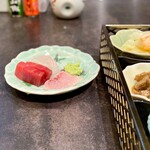

真珠が似合う子豚
3.60
I visited for the first time and looking at past reviews, it seems like the spiny lobster, chirashi sushi, and spiny lobster miso soup are popular choices. The presentation is great and the prices are reasonable. However, if there are only a few staple dishes, it might be hard to visit every month.



akiko1967
3.80
Had a Japanese dinner in Kitashinchi with my brother's family. We were picked up and had a fun evening. The grilled crab and kue were delicious, recommended by my brother. We had the chef's choice course, ranging from 8500 yen to probably 9500 yen for the private room. The bill was clear and transparent. Three adults had the course menu while the kids had sashimi and steak. Everyone had oolong tea. We started with an appetizer of shrimp, chrysanthemum greens salad, frozen stewed soft-shelled turtle, edamame, marinated egg yolk, shirako, octopus eggs, and rapeseed flowers. We also had aged tofu with a cheese-like flavor. I wanted to drink sake. We had Ise lobster and abalone, assorted sashimi, grilled Marushin and Kurasitare, Matsuba crab from Tottori, kue hot pot, chirashi sushi, Ise lobster soup with rice cakes, and warabi mochi. The kue weighed 29 kilograms and was delicious without any fishy smell. The steak was a bit too rare but tasty. We wanted to grill the crab on charcoal but couldn't due to the smoke, so they grilled it again. The steak was tender and easy to eat with chopsticks. Looking forward to trying new dishes with the changing seasons. The restaurant was fully booked despite the rain and pandemic. It's a great place to enjoy seasonal ingredients. Thank you to my brother for the treat.




吟遊食人
3.50
At the New Year's party, we had a variety of dishes including tofu with soybeans, shrimp and lotus root salad, simmered soft-shelled turtle, shirako with sea urchin, and steamed abalone. For sashimi, we had lobsters, abalone, flounder, sea bream, and tuna. The turtle soup was delicious, and we also enjoyed grilled crab and hot pot. The meat dishes and sushi were also excellent. The miso soup with lobster was a nice touch, and the dessert was a perfect way to end the meal. Overall, the menu was quite extensive, but I think simpler dishes like seasonal rice would have been preferable.




zzz
3.70
I was drawn to the daily lunch special called "Tea Picking Meal" with kue rice and kue soup. Is it really possible to eat kue for 1000 yen including tax? Let's find out. The restaurant has a luxurious feel typical of Shinchi. The Tea Picking Meal includes beef cutlet, mapo tofu, pork belly and daikon stew, steamed shrimp with turnip, rolled omelette with broth, simmered root vegetables, and simmered beans, all with generous portions. Each dish is carefully crafted. The kue soup features the first kue of the season, with a rich kue flavor despite the small amount of kue meat. The kue rice has plenty of kue scraps and crispy rice. Using the high-quality fish kue generously in a lunch set priced at 1000 yen is a great deal. This makes you want to visit for dinner as well. Located at Shin-Nihon Shinchi Building East Wing 1F, 1-7-6 Sonezaki Shinchi, Kita-ku, Osaka City.




くるみ1234
3.60
Visit by recommendation. The power starts from the appetizers. There are about 6 elaborately prepared dishes, each with a strong flavor that is satisfying! The spiny lobster and abalone were fresh and delicious. This time, I tried the abalone liver for the first time! I think it's rare. It had a rich taste. The atmosphere of the restaurant and the service are excellent, so I highly recommend it.



chibaco87
3.80
- A restaurant that is suitable for entertaining in Kitashinchi.
- The chilled abalone is delicious.
- Three private rooms available.
- Skilled artisans.
- A popular long-standing establishment.
- Willing to accommodate requests based on the season.
- Regular customers can request custom dishes in advance.
- A high-end restaurant.



Email Login